Pumicestone Catchment Convergence Feb 2021 – Workshop notes for Agriculture theme (scribe: Graham Webb)
Knowledge gaps / Issues / Other comments | Recommended responses / Opportunities |
WHOLE OF CATCHMENT – Farming and forestry
|
|
Northern Pumicestone Passage
|
|
Southern Pumicestone Passage
|
|
Bribie Island
|
|
Forestry estate – mainland
|
|
Major urban areas |
|
Eastern agricultural areas
|
|
Page 1
- Increasing recreation issues associated with increasing population
- Support from partners to get state (etc0 support
- Permit HQP to close areas to motorised activities and other restrictions to activities
- Losing plantation area to development
- Asbestos removal: road repairs
- Education of new residents to motivate WHY good behaviour??
- Feel like they’re contributing
- Other issue = litter in forestry – driven by cost of dumps => subsidise collection and longer hours
- “precision agriculture” e.g. Netherlands => efficient use of space (increase yield/ha) (espe berries; => “substrate” farming)
- Huge investment upfront: beyond capability of individual growers
- Labour shortage!! National ~crisis => education to overcome ignorance
- * GW: collective support to industry – including education
- Establish markets and mechanism for agricultural waste recycling e.g. plastics (also includes…)
- * GW: Adopt ~Netherlands practices while we still have environments
- Next group
- Closing the loop! Work with other industries e.g. water, waste
- Increase recognition of good individual growers and incentives and support
- Increase/bring back state/NRM extension programs
- Labelling/promotion to link good practice to brand benefits
- Knowledge gap – GRP – quantify negatives e.g. addressing poor behaviour
- Good quality agricultural land – how is it measured? How info used/not used => protect better through strong planning
Page 2
- Actions…
- => towards regenerative ag! E.g. agroforestry/permaculture! – nature-based solutions e.g. floating wetlands (HOW we farm…)
- Stronger collective consideration of non-traditional farming
- => create very strong value for local, green produce – ok to pay a little more; badge
- Increase research – underpin better management
- Change international import <=> export system => ”appreciate a job well done”
- Next group
- Observation – covid has helped people appreciate better
- => learn from traditional knowledge <=> landscape considerations e.g. lifting land; water re-direction => ripple effects
- [=> increase valuing by farmers of soil, water, etc INPUTS into production]
- Agricultural= vulnerable to climate variation; not a given
- Increase knowledge – $ of good natural resources
- Increase education of value of farming to regional amenity/landscapes
Page 3
- “vertical farming”??
- Encourage locals to buy local! => local produce and jobs
- Fresh; “farm to table”
- Are we growing the right things in the right places?? => WHERE?
- => intelligent and active development (including agricultural=> HOW?
- Requires community education and valuing!
- Community/co-op farms?? => investigate models for SC => overcome resource limitations per
- => consider merits of seaweed farm off BI
- Education/farm visits
- Next group
- In planning schemes: urban development prioritised above quality agricultural land
- * if we have another urban expansion into agricultural land, we will lose the INDUSTRY
- Elevate importance of agricultural land!!
- Retail pricing set behind scenes/international trade agreements => international produce cheaper than local! 🙁
- Pursue sustainable farming > industrial
- Supported by necessary research
CATCHMENT AREA rotation (agriculture group)
Northern Passage
- More local coastal erosion studies for northern BI – build on previous
- ?? cumulative impacts of Aura and (future) Beerwah East on water quality and habitats and fauna (e.g. birds, dugong, fish)
- Consolidate assessment of impacts and COMMUNICATE impacts to broader community
- Assess emerging impacts on Westaways marine NP (fish, water mouse?)
- Place for everyone; everyone in their place!
Southern Passage
- ?? dugong => communicate/educate => motivate positive change; => protect those populations/visitors
- Sediment loads from forestry/4WDs; ?? cumulative loads; effectiveness of fringing wetlands as buffers
- ( norther) – ?? displacement of habitats/loss from SLR and increased temperatures
- ?? * windfarms in passage
- Revise management regulations based on improved knowledge (e.g MP activities); => promote values!! ! ecosystem services
Bribie Island
- Less issues in forestry e.g. less 4WDs; arson; => promote values to comm of industry; counter community angst esp wrt harvesting, replanting
- issue = climate change/SLR – highest pot 2.5m; 1m SLR by 2100 => !!!!
- ?? value of BI as buffer for mainland
- ?? land/water opportunities – renewable energy??
Forestry
- consolidate buffers E-W; link PP to hills
- promote sustainability initiatives to protect buffers an WQ
- ** 4WD; litter; fire
- strips adjoinig Caboolture (S) and Caloundra (N) = worst => waste disposal facilitities/accessibility <=> subsidies
- B-East => compensate 5000ha loss e.g. 2:1 land swap
- Northern/SCC
- Ensure major developments support linkages b/w surrounding LUs => Bruce Highway!! => investigate retrofitting wildlife passage
Eastern agricultural areas
- ?? assess actual eco/toxicity impacts of agricultural pollutants by end of cmt
